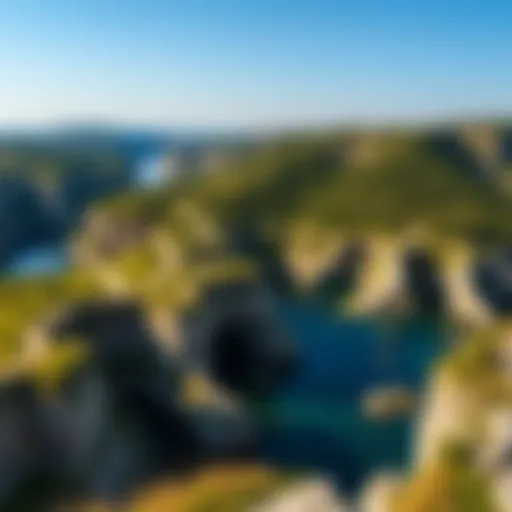Exploring the Allure of Dubai: A Travel Guide
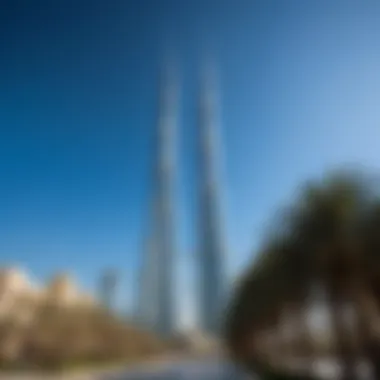

Intro
Dubai, officially known as DXB, stands as a captivating intersection of various cultures found within a contemporary urban landscape. Its rapid growth, from a modest fishing village to a global tourism hub, is remarkable. The city seamlessly intertwines history and modernity, where traditional souks exist alongside towering skyscrapers like the Burj Khalifa. In this article, we will delve into Dubai's key attractions, travel tips, and cultural nuances that make it a distinctive destination.
Popular Destinations
Unique Locations for Exotic Travels
Dubai is known for its remarkable attractions that draw millions of visitors each year. Key destinations include the Dubai Mall, one of the largest shopping centers in the world, boasting over 1,200 retail outlets, an aquarium, and an ice rink.
Other must-see spots include:
- Burj Khalifa: Experience breathtaking views from the world's tallest building.
- Palm Jumeirah: An artificial island offering luxurious resorts and stunning beaches.
- Desert Safari: Adventure through the dunes, engaging in activities like dune bashing and camel riding.
The combination of modern architecture with rich Emirati traditions creates a unique atmosphere. Not to forget the historical precinct of Al Fahidi, where traditional wind-tower architecture and the Dubai Museum provide insight into the city’s past.
Comfortable Places for Family Leisure
For families, Dubai presents numerous options to enjoy quality time together. Consider visiting:
- Aquaventure Waterpark: Located at Atlantis, The Palm, this park offers thrilling slides and a relaxing lazy river.
- Dubai Aquarium: Situated in Dubai Mall, this is one of the largest suspended aquariums, without the need to pay for entry if you just want to observe from outside.
- Global Village: A seasonal theme park that combines culture, shopping, and entertainment, showcasing various countries.
Family-friendly attractions show Dubai’s commitment to providing fun and education simultaneously.
Preparing for Your Journey
Tips for Route Selection
Deciding the best time to visit is crucial for a pleasant experience. The cooler months from November to March are ideal, with temperatures ranging from 24-30°C. When planning the itinerary, think about what interests you most whether it's shopping, cultural experiences, or adventure activities.
How to Pack: Useful Tips
Pack light, breathable clothing suitable for the warm climate. A hat and sunglasses are essential items given the sun's intensity. Swimwear is also important for enjoying the various beaches and waterparks. Also, don't forget to bring a pair of comfortable shoes for exploring.
Using packing cubes can help you organize your belongings efficiently. Consider also a power adapter for your electronic devices, as Dubai uses the British-style Type G socket.
"When packing for Dubai, think about versatility and comfort. Your wardrobe should reflect both the climate and local customs."
Navigating through Dubai’s vibrant landscape requires thoughtful preparation. With the information provided, travelers can immerse themselves fully in this intricate blend of modernity and tradition that Dubai represents.
Intro to Dubai
Dubai stands as a testament to human innovation and adaptability. As a global hub, it attracts tourists from all corners of the planet. Understanding this city is key for anyone considering a visit. The diverse mix of cultures, traditions, modern architecture, and economic growth makes Dubai a fascinating place to explore. This section lays the groundwork for a deeper understanding of the city’s geographical, historical, and economic context, which are all vital for visitors.
Geographical Overview
Dubai is located on the southeastern coast of the Arabian Peninsula, specifically by the Arabian Gulf. Its territory covers 4,114 square kilometers, an area that has undergone significant transformation from desert landscape to a modern metropolis. The city is bordered to the south by Abu Dhabi and to the north by Sharjah, making it strategically important within the United Arab Emirates.
The climate is characterized by hot summers and mild winters. During summer months, temperatures can soar above 40 degrees Celsius, a fact visitors should note when planning their trips. The city’s strategic position as a junction for international travel further enhances its appeal. Its proximity to significant trade routes contributes to its economic stature.
Historical Background
The history of Dubai is rich and layered. Originally, it was a modest fishing village inhabited by nomadic Bedouins in the 19th century. Following the arrival of the Al Maktoum family in 1833, the city began to develop and expand. In 1966, oil was discovered, which catalyzed dramatic changes in its infrastructure and economic landscape.
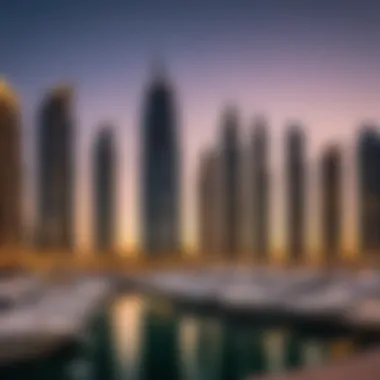

The transformation over the last few decades is remarkable. From a small port town, it evolved into a major commercial and tourism hub. The government’s vision to diversify the economy has led to developments like the Burj Khalifa and various luxury malls. Today, Dubai is known for its rapid growth, luxury lifestyle, and unique cultural experiences, but its origins remain a paramount part of its identity.
Economic Significance
Dubai's economy is diversified, extending beyond oil, which now constitutes a small percentage of its GDP. The city thrives on tourism, real estate, and finance. The Dubai Mall and Burj Khalifa are prime examples of how investment in tourism has paid off.
The tax-free environment attracts expatriates and businesses alike, providing a vibrant market for investments. Furthermore, the city's business-friendly policies make it a hotspot for startups and large corporations. Tourism alone contributes billions to the economy, drawing millions annually.
Cultural Landscape
The cultural landscape of Dubai is a rich tapestry woven from various threads of tradition and modernity. This aspect of Dubai plays a significant role in attracting tourists who seek authentic experiences alongside the city's impressive skyline and luxury. Understanding the cultural landscape enriches a traveler’s visit, providing insights into the local way of life, values, and societal norms.
Traditions and Customs
Dubai is deeply rooted in its traditions and customs, which stem from its Bedouin heritage. Hospitality is a cornerstone of their culture; visitors often experience warm welcomes and generous acts of kindness. Traditional practices, such as drinking coffee or serving dates, showcase the significance of bonding and sharing.
Another essential tradition is dress code; while Dubai is more liberal than many other Middle Eastern cities, modesty is still emphasized in public spaces. The Emirati dress, known as kandura for men and abaya for women, signifies identity and respect for cultural roots.
Festivals and Celebrations
Dubai hosts a variety of festivals that reflect both its religious and cultural diversity. The most notable among them is Eid al-Fitr, marking the end of Ramadan. This celebration features community gatherings, feasting, and prayers. Additionally, the Dubai Shopping Festival attracts visitors with its price cuts and entertainment events, blending commerce with celebration.
These festivals provide tourists an opportunity to witness the city's vibrant spirit and partake in local customs. Participating fosters understanding and close connection with Emirati people, enhancing the overall travel experience.
Culinary Diversity
Dubai's culinary scene is a microcosm of its cultural diversity. The city is home to flavors from all corners of the world, with international cuisine thriving alongside traditional Emirati dishes. Local specialties such as shawarma, falafel, and hummus showcase Middle Eastern culinary heritage.
Dining in Dubai is more than just eating; it is an experience where travelers can indulge in various settings, from luxurious restaurants to street food stalls. Upscale venues feature world-renowned chefs, while traditional eateries offer authentic meals in atmospheric surroundings. This culinary diversity not only caters to different palates but also highlights the blending of cultures through food.
"Food is a central part of Dubai's cultural identity, reflecting its history and embracing global influences."
Major Attractions
The significance of major attractions in Dubai cannot be overstated. They serve as the backbone of the tourism industry, drawing millions of visitors each year. These landmarks showcase the remarkable blend of tradition and modernity that defines Dubai. Tourists seeking memorable experiences and cultural enrichment will find much to explore in this vibrant city. Understanding these attractions is essential for both seasoned travelers and those new to the region. Visiting these sites contributes to a better appreciation of Dubai's unique character.
Iconic Landmarks
Dubai is home to a plethora of iconic landmarks that symbolize its rapid growth and ambition. The Burj Khalifa, the tallest building in the world, stands as a testament to human ingenuity and modern architecture. At a staggering height of 828 meters, its observation decks offer breathtaking views of the cityscape and beyond. Nearby, the Dubai Fountain provides a captivating display of water choreography set to music, attracting crowds with its mesmerizing performance.
Another significant landmark is the Palm Jumeirah, an artificial island shaped like a palm tree. It is a prime example of Dubai's vision for luxury living and vacationing. Here, visitors can enjoy high-end resorts such as Atlantis, The Palm, which features an aquarium and a water park, making it an appealing destination for families and thrill-seekers alike.
In addition, the historic Al Fahidi District showcases traditional Emirati architecture and culture. The narrow alleys and wind towers transport visitors back to a time before the skyscrapers. Here, the Dubai Museum offers insights into the city’s rich heritage, making it an integral stop for history enthusiasts.
"Dubai's skyline tells a story of ambition and innovation that is hard to ignore."
Shopping Destinations
Dubai is often referred to as a shopping paradise. The city is home to numerous malls and souks, offering a variety of shopping experiences. The Dubai Mall is one of the largest shopping centers in the world, housing over 1,200 retail stores, which range from high-end fashion to local brands. It also contains unique attractions such as an indoor ice rink and an aquarium, making it more than just a shopping destination.
Additionally, the Gold Souk in Deira presents a different charm. This traditional market specializes in gold jewelry, providing a rich sensory experience with its vibrant displays and bustling atmosphere. Shoppers can find intricate designs and potentially engage in bargaining, a skill valued in local culture.
For an alternative shopping experience, the Global Village seasonally combines various cultures from around the world, presenting diverse goods and foods. Visitors can explore pavilions from different countries, making it a delightful stop for souvenirs and culinary treats.
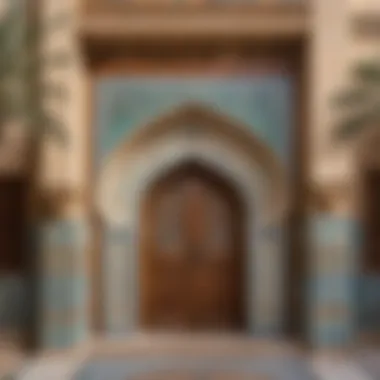

Adventure and Activities
Dubai's landscape offers a wealth of adventure and activities for those seeking excitement. A desert safari is a must-do for visitors. These tours typically include dune bashing, camel rides, and traditional dinner experiences under the stars. It provides a unique way to witness the natural beauty and serenity of the Arabian desert, contrasting sharply with the city's urban environment.
Water sports are also popular in Dubai. Visitors can try jet skiing, parasailing, and even deep-sea fishing in the warm waters of the Persian Gulf. Resorts such as Jumeirah Beach Hotel offer excellent facilities for water sports, ensuring visitors have access to a range of activities.
For thrill-seekers, the IMG Worlds of Adventure theme park is a notable destination. This indoor amusement park provides a range of rides and attractions suitable for all ages. It creates an entirely different experience that combines entertainment with the thrill of adventure.
In summary, Dubai's major attractions—from iconic landmarks to diverse shopping venues and adventure opportunities—provide a comprehensive experience. These elements not only attract visitors but also contribute to a deeper understanding of the city’s culture and modern evolution.
Navigating the City
Navigating Dubai is a crucial part of experiencing this dynamic metropolis. The city's layout, unique blend of modern and traditional elements, and extensive range of transportation options give travelers the means to explore its rich tapestry with ease. Understanding how to move around will help optimize your time and ensure you access all the notable attractions, whether they are ancient souks or stunning skyscrapers. This section outlines critical aspects that will enhance your journey through the city, ensuring a seamless experience for all types of travelers.
Transportation Options
Dubai offers various transportation modes that cater to different preferences and budgets. The Dubai Metro is a modern and efficient option, connecting key areas of the city. Its cleanliness and punctuality make it a popular choice among locals and visitors alike. The trains run frequently, and an automated ticketing system simplifies fare payments. Other choices include trams, which provide easy access to popular neighborhoods.
For those who prefer a more personal touch, taxis are readily available. They are metered and offer convenient travel throughout the city. Alternatively, using ride-hailing services like Uber or Careem is another excellent option, providing an app-based solution that many find appealing.
Public buses serve as an economical choice for those on a budget. They are extensive and link various parts of the city, though they may be less comfortable compared to other modes.
Finally, for those who desire an authentic experience, consider using abra boats. These traditional wooden boats ferry passengers across Dubai Creek and offer a picturesque view of the city.
Best Time to Visit
Timing your visit to Dubai can significantly enhance your experience. The most favorable period is between November and March. During these months, the weather is milder and more pleasant, ideal for outdoor activities and sightseeing. High temperatures in summer can reach unbearable levels, often exceeding 40°C, making outdoor exploration challenging.
It is also essential to consider major events and festivals. The Dubai Shopping Festival typically occurs in January, attracting bargain hunters and those looking for entertainment. The Dubai World Cup, a prestigious horse race, takes place in March, and is another must-see for visitors. Planning ahead and aligning your trip with these events can ensure a rich experience with the city's extraordinary cultural vibrancy.
Accommodation Choices
Dubai boasts a wide array of accommodation options, catering to varying preferences and budgets. Luxury seekers may opt for opulent hotels like the Burj Al Arab or the Atlantis The Palm, both of which provide unparalleled services and stunning views.
For those traveling on a budget, numerous options exist. Hostels and budget hotels are dispersed throughout the city, especially in areas like Deira and Bur Dubai. These choices offer affordable rates without sacrificing comfort.
Serviced apartments are gaining popularity as well, providing a blend of flexibility and home-like convenience. They are especially suitable for families or travelers planning an extended stay.
When selecting accommodation, consider proximity to the metro or bus lines. This ensures ease of access and can minimize travel time to key attractions.
"Understanding transportation and accommodation in Dubai is key to unlocking its wonders. Plan wisely to enjoy your visit.
Local Insights
Understanding local insights when visiting Dubai is essential for an enriching experience. This section explores how being aware of the city’s customs and safety practices can enhance interactions and facilitate a comfortable stay. Travelers benefit significantly by fostering positive relationships with locals, which can lead to authentic experiences and valuable connections. Each aspect discussed here will prepare visitors for nuances they might encounter in this cosmopolitan environment.
Understanding Local Etiquette
Dubai's culture is deeply rooted in tradition and values. Familiarizing oneself with local etiquette helps avoid unintentional misunderstandings. Here are a few key points:
- Dress modestly: While Dubai is more liberal than some neighboring regions, modest dress is still appreciated, especially in public areas and religious sites. Opt for clothing that covers shoulders and knees.
- Greetings: A simple handshake is common, but respect local customs by allowing locals to initiate contact. In some cases, it may be acceptable to greet with phrases in Arabic such as "As-salamu alaykum" (peace be upon you).
- Dining manners: When sharing meals, wait for the host to start. Use your right hand for eating, as the left hand is considered unclean.
These nuances in local etiquette can significantly enhance mutual respect and create a favorable atmosphere for interaction.
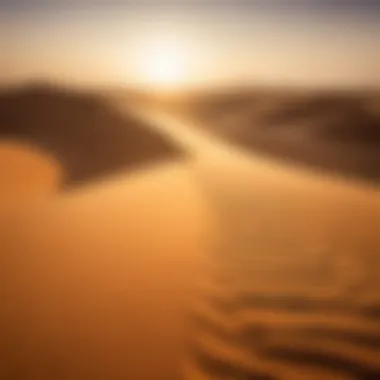

Safety Considerations
Dubai is often regarded as one of the safest cities in the world. The low crime rates contribute to a secure environment for both residents and visitors. However, it's important to exercise general caution. Here are some safety considerations:
- Stay aware of surroundings: Like in any urban environment, remain vigilant, especially in crowded places.
- Accessing emergency services: Familiarize yourself with emergency numbers. For instance, the police can be reached by dialing 999.
- Respect local laws: Dubai has strict laws, especially concerning substance use and public behavior. Being informed about these rules helps in avoiding legal troubles.
By understanding these factors, travelers can enjoy their time in Dubai with peace of mind.
Language and Communication
Arabic is the official language of the UAE, but English is widely spoken, particularly in business and tourism sectors. This bilingual environment facilitates communication for international travelers. Here are some useful tips:
- Learn basic Arabic phrases: Simple phrases can go a long way. "Shukran" (thank you) and "Afwan" (you’re welcome) can help in building goodwill.
- Using translation apps: Apps like Google Translate can assist in bridging communication gaps.
- Cultural sensitivity: When addressing locals, use honorifics and show respect. This enhances interactions and shows appreciation for their culture.
Overall, while language may not be a barrier in Dubai, appreciating its linguistic diversity can improve social interactions.
Being informed about local insights can transform a superficial visit into a culturally immersive experience.
Exploring Surrounding Areas
Exploring the surrounding areas of Dubai is essential for travelers seeking a fuller experience of the UAE. While Dubai is a showcase of modernity and luxury, its neighboring regions offer rich cultural history and natural beauty. These areas provide a contrast to the city, offering insights into the UAE's heritage and landscapes. Engaging with these places can enhance one’s understanding of the emirate and its people, making the trip more rewarding and memorable.
Day Trips from Dubai
Dubai's location allows for numerous exciting day trips. One of the most popular destinations is Abu Dhabi, the capital of the UAE, which is just a short drive away. Visitors can explore the stunning Sheikh Zayed Grand Mosque, known for its intricate design that combines traditional and modern architectural elements.
Another option is the historical city of Sharjah, which boasts a rich cultural scene with museums and art galleries. The Sharjah Arts Museum and the Islamic Art Museum are notable spots worth a visit.
For those interested in adventure, a day trip to the Hatta region offers outdoor activities such as hiking, kayaking, and mountain biking. Hatta's picturesque landscapes are a stark contrast to the urban environment of Dubai and invite exploration.
Cultural Excursions
Cultural excursions from Dubai can deepen travelers' appreciation for the UAE’s rich traditions. One key location is the heritage village in Abu Dhabi, where visitors can witness craft demonstrations and learn about local customs.
In addition, trips to Ras Al Khaimah can provide insights into traditional Emirati life. The National Museum of Ras Al Khaimah is a treasure trove of artifacts that trace the history of the region from ancient times to the present.
Exploring Al Ain, known as the "Garden City," also offers cultural insights. The Al Ain Oasis and the UNESCO-listed Al Jahili Fort showcase the region's agricultural heritage and fortification history, which contrast the modernity of Dubai.
Natural Attractions
The natural attractions surrounding Dubai are awe-inspiring and should be included in any itinerary. One of the most famous is the Dubai Desert Conservation Reserve. This protected area is ideal for experiencing the beauty of sand dunes and wildlife unique to the Arabian Peninsula.
Another noteworthy site is the Hajar Mountains, which provide breathtaking views and opportunities for hiking. The contrast between the mountains and the desert showcases the UAE’s diverse topography.
Finally, the coastline along the Arabian Gulf offers stunning beaches and serene environments for relaxation. Locations such as Jebel Ali and the beaches of Fujairah are perfect for those wanting a break from the city bustle.
Exploring surrounding areas allows travelers to appreciate the multifaceted landscape of Dubai and the larger Emirate context, enriching their overall travel experience.
The End
In this comprehensive exploration of Dubai, the conclusion serves as a critical reflection on the unique characteristics that define the city. Dubai is not just a travel destination; it represents a crossroads of cultures, histories, and economies. Understanding the evolution of Dubai enriches the overall experience for travelers. It reveals the layers of tradition that lay the groundwork for the city's modern success.
Reflecting on Dubai's Evolution
Dubai's transformation from a modest fishing village to a global metropolis is remarkable. This evolution reflects significant investment, strategic planning, and, notably, a commitment to diversity in growth. The creation of free zones and a focus on tourism have transformed its economic landscape. Today, Dubai thrives on various sectors such as finance, tourism, and trade. The architectural marvels, such as the Burj Khalifa and the Palm Jumeirah, symbolize this shift. Each structure tells a story of ambition and innovation, mirroring the city's ethos. This transformation is not solely economic; cultural exchanges have flourished as well. Multiculturalism is integral to Dubai's identity. By recognizing this historical context, travelers can appreciate the contrast between old souks and contemporary skyscrapers.
Final Thoughts for Travelers
Travelers heading to Dubai should approach the city with an open mind. The blend of tradition and modernity is not only fascinating but essential to the visitor experience. Engaging with locals, participating in annual festivals, and trying traditional cuisine provides deeper insights into the city's soul. Knowing when to visit is equally important, as seasons can vary significantly in climate and activities. Some may find the summer sweltering, while the cooler months offer outdoor events and vibrant festivals.
Moreover, travelers should remain aware of cultural nuances. Respecting local customs and etiquettes goes a long way in creating meaningful interactions. Dubai is a canvas where cultures merge, and each visitor plays a role in that ongoing story. As one prepares for a journey through Dubai, reflection on its profound evolution will surely enhance the exploration ahead.





